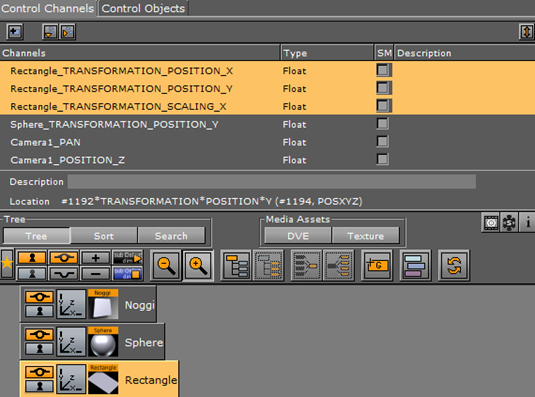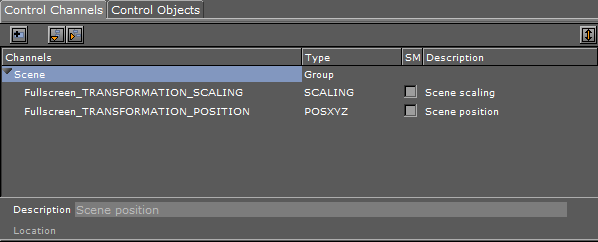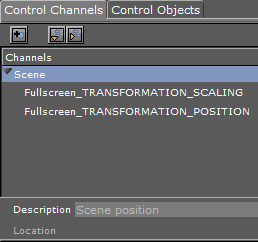
Viz Artist User Guide
Version 3.13 | Published March 28, 2019 ©
Control Channels
Parameters in a Scene can be exposed for use with external controls, meaning these exposed parameters can be modified by an external control application, such as Viz Libero, Viz Trio or Viz Pilot. To expose parameters, the parameters can be dragged to the Control Channel panel and configured.
Although parameters can be set through a Command Interface, the Control Channels offer three advantages:
-
Only parameters which should or can be modified, are exposed in certain external control applications (which use control channels).
-
Instead of a long command string (as used in a Command Interface), a control channel name points to the parameter location, where “@” in the command location is the indicator for a control channel name.
-
Multiple Control Channels can have the same name, allowing them all to be updated in a single operation.
Control Channels can also be added from the Stage. To make this possible, the Control Panel can be floated. This enables the Control Panel to be viewed in all views of Viz Artist.
Most parameters can be added to the Control Channels. Properties that can be added to the Controls Channels are:
-
Properties Panel: Container, Camera, Light and Scene Settings tabs
-
Server Tree: Containers, Geometries, Materials
-
Server Panel: Geometries, Materials
-
Stage: Editors and parts of Editors, i.e., Director parameters, Channel Editor, Key Frame Editor, Stops and Tags, Action Key Frames.
Navigating scenes with extensive use of Control Channels is made easy, as Viz Artist automatically selects all Control Channels belonging to a container when the container is selected. Correspondingly, selecting a single Control Channel also selects the container it belongs to.

Control Channels can also be grouped. This provides a convenient way to group a series of parameters which can be controlled from an external source.
Example: Click on the Container tab > Transformation Editor. Drag the parameter Position X of an Object to the Control Channels panel. This exposes Position X of that object.
Example: In the Properties panel, click on the Camera tab and drag a camera’s Position Y parameter to the Control Channels panel. This exposes Position Y of that camera.
Example: In the Stage, click on the header of a Key Frame editor (in-line with the  ) and drag it to the Control Channels panel. This gives access to all parameters contained in the Key Frame editor. To add control channels from the Stage, Control Channels need to be floated.
) and drag it to the Control Channels panel. This gives access to all parameters contained in the Key Frame editor. To add control channels from the Stage, Control Channels need to be floated.
This section contains the following procedures:
Control Channels Properties

-
 : Click to add a new group
: Click to add a new group -
 : Opens or collapses the Control Channels tree
: Opens or collapses the Control Channels tree -
 : Floats the Control Channels panel
: Floats the Control Channels panel -
 : Docks the Control Channels panel
: Docks the Control Channels panel -
Channels, Type, SM, Description: Exposed parameter details.
If required, click in the SM box to synchronize the Channel values with the corresponding key-value pair in the Scene Shared Memory Map.Note: The Shared Memory key syntax for grouped control channels is <groupname>.<channelname>, for example, MyGroup.Rectangle_TRANSFORMATION_POSITION_X.
-
Description: Adds a description for the exposed parameter.
-
Location: Shows command location of the command.
Control Channels Procedures
To Dock and Float the Control Panel
To access parameters in the Stage, the Control Panel can be floated and used as a floating panel, available in all Viz Artist panels:
![]()
-
Click
 to float the Control Panel.
to float the Control Panel. -
Click the
 to dock the Control Panel.
to dock the Control Panel.
To Create a Control Channel
-
Click Control.
-
Select a parameter to expose, from:
-
Properties Panel: Container, Camera, Light and Scene Settings tabs
-
Server Tree: Containers, Geometries, Materials
-
Server Panel: Geometries, Materials
-
Stage: Editors and parts of Editors (i.e., Director parameters, Channel Editor, Key Frame Editor, Stops and Tags and Action Key Frames).
-
-
Drag the selected parameter to the Control Channel panel.

-
Type a name for the exposed parameter (or use the name provided).

-
Click on the exposed parameter.
-
Type a Description (1) for the exposed parameter, if required.
-
Click in the SM box to synchronize the Channel values with Shared Memory, if required.

-
To add a second, third, fourth, or more exposed parameters, repeat from step 1.
Note: When a new parameter is dragged to the Control Channels panel an icon shows where the new parameter is dropped in the list
 .
.
To Remove Exposed Parameters
Drag an exposed parameter, or multi selected exposed parameters, to the Trash Can.
To Create a Group

-
Create a new group:
-
Click on
 , or
, or -
Drag the
 icon to the main Control Channels panel
icon to the main Control Channels panel
-
-
Type a descriptive group name.

-
Type a description for the new group.

-
Drag an exposed parameter, or multi selected exposed parameters, to the group:
-
Drag from the Controls Channels panel, or
-
Drag directly from the Properties panel or Stage
-
-
Drop the exposed parameter in the group when
 shows.
shows. 
-
When a group contains an exposed parameter an arrow shows to its left. Click on the arrow to show the groups contents.

See Also